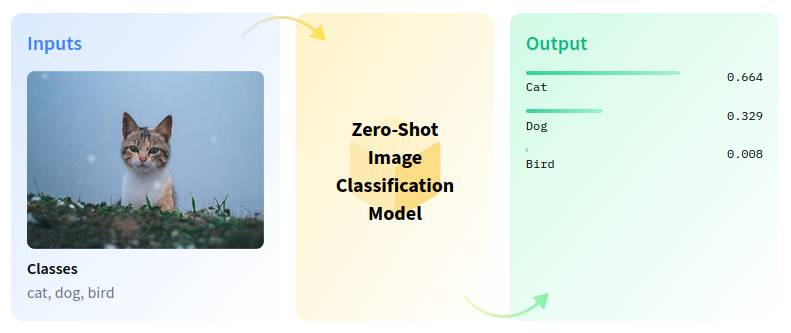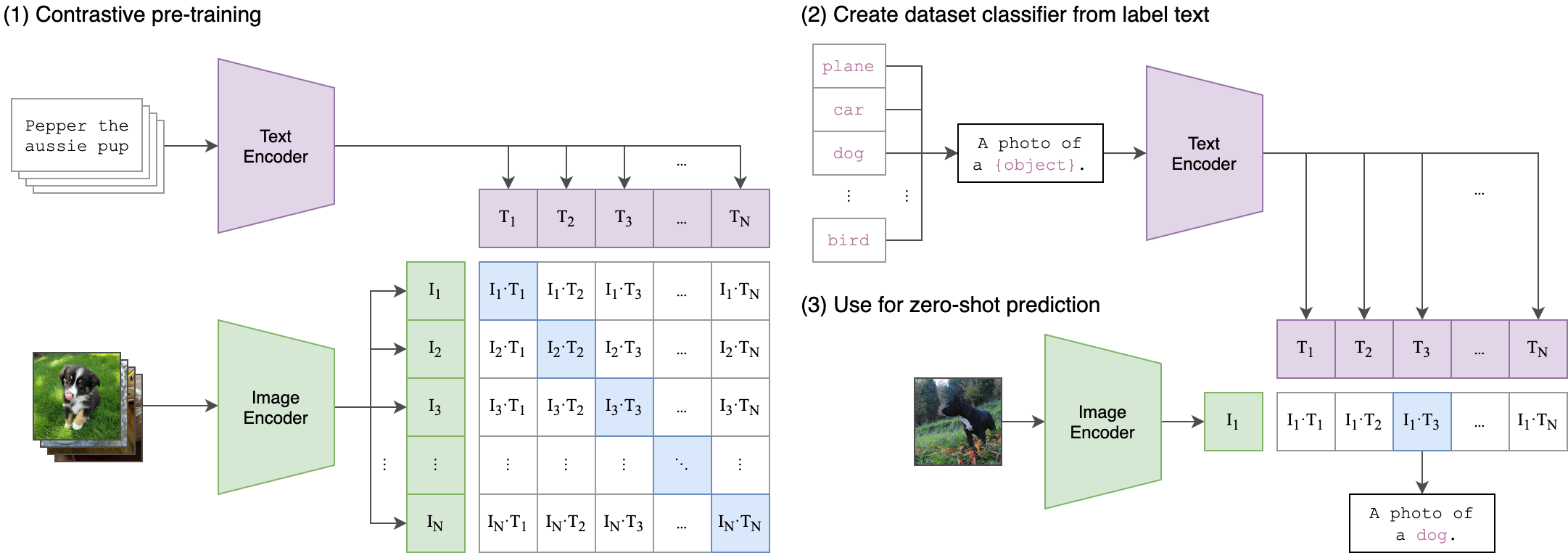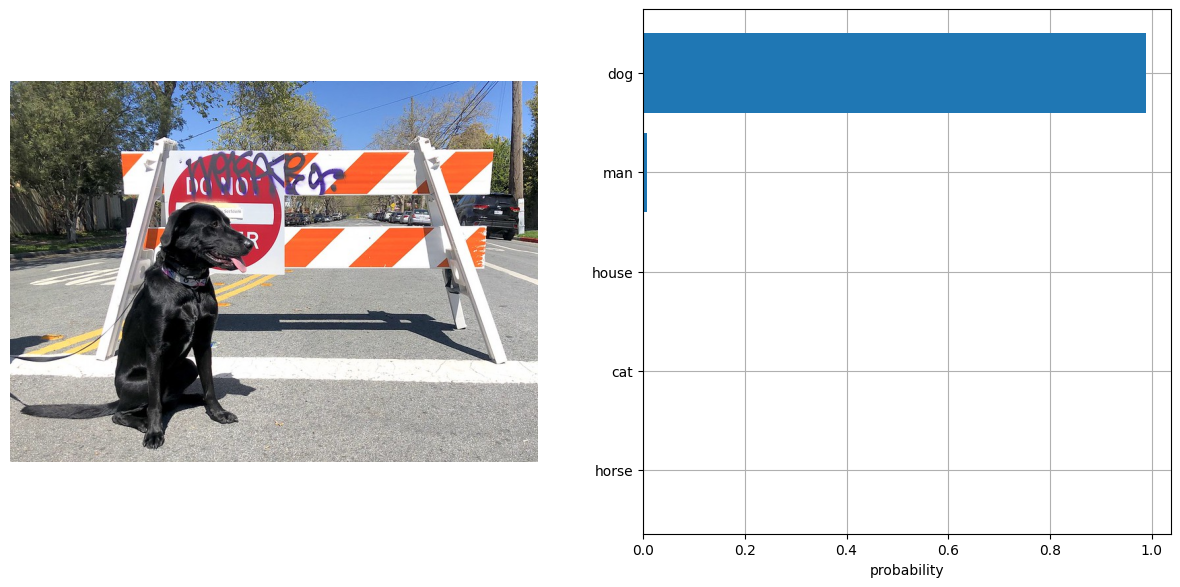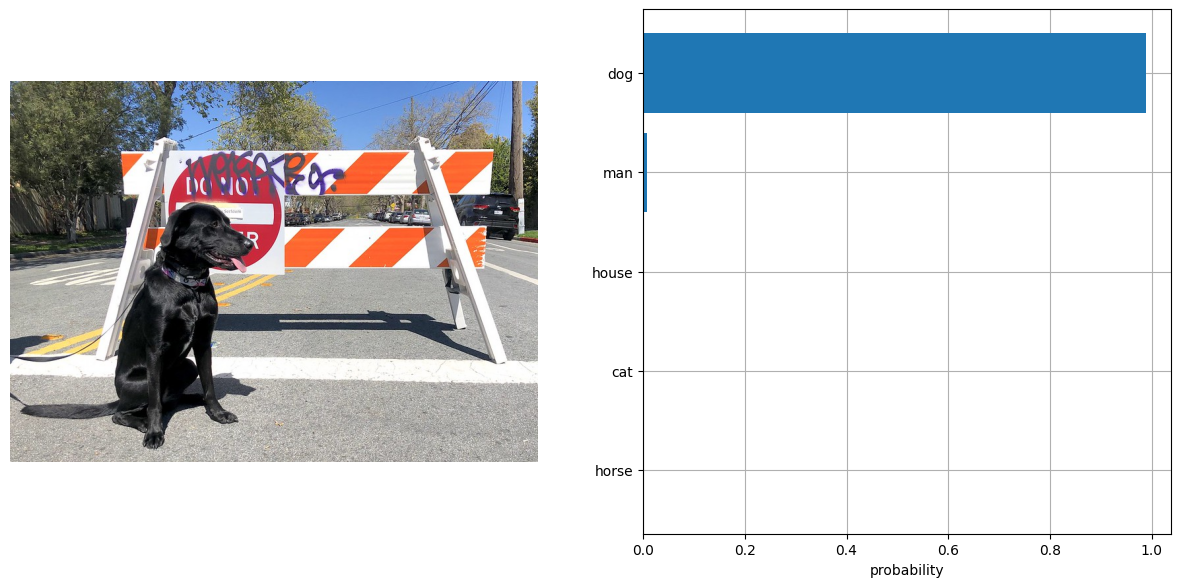Zero-shot Image Classification with OpenAI CLIP and OpenVINO™¶
This Jupyter notebook can be launched after a local installation only.
Zero-shot image classification is a computer vision task to classify images into one of several classes without any prior training or knowledge of the classes.

zero-shot-pipeline¶
Zero-shot learning resolves several challenges in image retrieval systems. For example, with the rapid growth of categories on the web, it is challenging to index images based on unseen categories. We can associate unseen categories to images with zero-shot learning by exploiting attributes to model’s relationship between visual features and labels. In this tutorial, we will use the OpenAI CLIP model to perform zero-shot image classification. The notebook contains the following steps:
Download the model.
Instantiate the PyTorch model.
Convert model to OpenVINO IR, using model conversion API.
Run CLIP with OpenVINO.
Table of contents:¶
Instantiate model¶
CLIP (Contrastive Language-Image Pre-Training) is a neural network trained on various (image, text) pairs. It can be instructed in natural language to predict the most relevant text snippet, given an image, without directly optimizing for the task. CLIP uses a ViT like transformer to get visual features and a causal language model to get the text features. The text and visual features are then projected into a latent space with identical dimensions. The dot product between the projected image and text features is then used as a similarity score.

clip¶
You can find more information about this model in the research paper, OpenAI blog, model card and GitHub repository.
In this notebook, we will use openai/clip-vit-base-patch16, available via Hugging Face Transformers, but the same steps are applicable for other CLIP family models.
First, we need to create CLIPModel class object and initialize it
with model configuration and weights, using from_pretrained method.
The model will be automatically downloaded from Hugging Face Hub and
cached for the next usage. CLIPProcessor class is a wrapper for
input data preprocessing. It includes both encoding the text using
tokenizer and preparing the images.
%pip install -q --extra-index-url https://download.pytorch.org/whl/cpu gradio "openvino>=2023.1.0" "transformers[torch]>=4.30"
from transformers import CLIPProcessor, CLIPModel
# load pre-trained model
model = CLIPModel.from_pretrained("openai/clip-vit-base-patch16")
# load preprocessor for model input
processor = CLIPProcessor.from_pretrained("openai/clip-vit-base-patch16")
/home/ea/work/ov_venv/lib/python3.8/site-packages/torch/cuda/__init__.py:138: UserWarning: CUDA initialization: The NVIDIA driver on your system is too old (found version 11080). Please update your GPU driver by downloading and installing a new version from the URL: http://www.nvidia.com/Download/index.aspx Alternatively, go to: https://pytorch.org to install a PyTorch version that has been compiled with your version of the CUDA driver. (Triggered internally at ../c10/cuda/CUDAFunctions.cpp:108.) return torch._C._cuda_getDeviceCount() > 0 2023-10-26 14:25:33.940360: I tensorflow/core/util/port.cc:110] oneDNN custom operations are on. You may see slightly different numerical results due to floating-point round-off errors from different computation orders. To turn them off, set the environment variable TF_ENABLE_ONEDNN_OPTS=0. 2023-10-26 14:25:33.975867: I tensorflow/core/platform/cpu_feature_guard.cc:182] This TensorFlow binary is optimized to use available CPU instructions in performance-critical operations. To enable the following instructions: AVX2 AVX512F AVX512_VNNI FMA, in other operations, rebuild TensorFlow with the appropriate compiler flags. 2023-10-26 14:25:34.675789: W tensorflow/compiler/tf2tensorrt/utils/py_utils.cc:38] TF-TRT Warning: Could not find TensorRT
Run PyTorch model inference¶
To perform classification, define labels and load an image in RGB
format. To give the model wider text context and improve guidance, we
extend the labels description using the template “This is a photo of a”.
Both the list of label descriptions and image should be passed through
the processor to obtain a dictionary with input data in the
model-specific format. The model predicts an image-text similarity score
in raw logits format, which can be normalized to the [0, 1] range
using the softmax function. Then, we select labels with the highest
similarity score for the final result.
from urllib.request import urlretrieve
from pathlib import Path
from PIL import Image
urlretrieve(
"https://raw.githubusercontent.com/openvinotoolkit/openvino_notebooks/main/notebooks/228-clip-zero-shot-image-classification/visualize.py",
filename='visualize.py'
)
from visualize import visualize_result
sample_path = Path("data/coco.jpg")
sample_path.parent.mkdir(parents=True, exist_ok=True)
urlretrieve(
"https://storage.openvinotoolkit.org/repositories/openvino_notebooks/data/data/image/coco.jpg",
sample_path,
)
image = Image.open(sample_path)
input_labels = ['cat', 'dog', 'wolf', 'tiger', 'man', 'horse', 'frog', 'tree', 'house', 'computer']
text_descriptions = [f"This is a photo of a {label}" for label in input_labels]
inputs = processor(text=text_descriptions, images=[image], return_tensors="pt", padding=True)
results = model(**inputs)
logits_per_image = results['logits_per_image'] # this is the image-text similarity score
probs = logits_per_image.softmax(dim=1).detach().numpy() # we can take the softmax to get the label probabilities
visualize_result(image, input_labels, probs[0])

Convert model to OpenVINO Intermediate Representation (IR) format.¶
For best results with OpenVINO, it is recommended to convert the model
to OpenVINO IR format. OpenVINO supports PyTorch via Model conversion
API. To convert the PyTorch model to OpenVINO IR format we will use
ov.convert_model of model conversion
API.
The ov.convert_model Python function returns an OpenVINO Model
object ready to load on the device and start making predictions. We can
save it on disk for the next usage with ov.save_model.
import openvino as ov
model.config.torchscript = True
ov_model = ov.convert_model(model, example_input=dict(inputs))
ov.save_model(ov_model, 'clip-vit-base-patch16.xml')
WARNING:tensorflow:Please fix your imports. Module tensorflow.python.training.tracking.base has been moved to tensorflow.python.trackable.base. The old module will be deleted in version 2.11.
[ WARNING ] Please fix your imports. Module %s has been moved to %s. The old module will be deleted in version %s.
/home/ea/work/ov_venv/lib/python3.8/site-packages/transformers/models/clip/modeling_clip.py:287: TracerWarning: Converting a tensor to a Python boolean might cause the trace to be incorrect. We can't record the data flow of Python values, so this value will be treated as a constant in the future. This means that the trace might not generalize to other inputs!
if attn_weights.size() != (bsz * self.num_heads, tgt_len, src_len):
/home/ea/work/ov_venv/lib/python3.8/site-packages/transformers/models/clip/modeling_clip.py:327: TracerWarning: Converting a tensor to a Python boolean might cause the trace to be incorrect. We can't record the data flow of Python values, so this value will be treated as a constant in the future. This means that the trace might not generalize to other inputs!
if attn_output.size() != (bsz * self.num_heads, tgt_len, self.head_dim):
/home/ea/work/ov_venv/lib/python3.8/site-packages/transformers/models/clip/modeling_clip.py:295: TracerWarning: Converting a tensor to a Python boolean might cause the trace to be incorrect. We can't record the data flow of Python values, so this value will be treated as a constant in the future. This means that the trace might not generalize to other inputs!
if causal_attention_mask.size() != (bsz, 1, tgt_len, src_len):
/home/ea/work/ov_venv/lib/python3.8/site-packages/transformers/models/clip/modeling_clip.py:304: TracerWarning: Converting a tensor to a Python boolean might cause the trace to be incorrect. We can't record the data flow of Python values, so this value will be treated as a constant in the future. This means that the trace might not generalize to other inputs!
if attention_mask.size() != (bsz, 1, tgt_len, src_len):
Run OpenVINO model¶
The steps for making predictions with the OpenVINO CLIP model are similar to the PyTorch model. Let us check the model result using the same input data from the example above with PyTorch.
from scipy.special import softmax
# create OpenVINO core object instance
core = ov.Core()
Select inference device¶
select device from dropdown list for running inference using OpenVINO
import ipywidgets as widgets
device = widgets.Dropdown(
options=core.available_devices + ["AUTO"],
value='AUTO',
description='Device:',
disabled=False,
)
device
Dropdown(description='Device:', index=2, options=('CPU', 'GPU', 'AUTO'), value='AUTO')
# compile model for loading on device
compiled_model = core.compile_model(ov_model, device.value)
# obtain output tensor for getting predictions
logits_per_image_out = compiled_model.output(0)
# run inference on preprocessed data and get image-text similarity score
ov_logits_per_image = compiled_model(dict(inputs))[logits_per_image_out]
# perform softmax on score
probs = softmax(ov_logits_per_image, axis=1)
# visualize prediction
visualize_result(image, input_labels, probs[0])

Great! Looks like we got the same result.
Now, it is your turn! You can provide your own image and comma-separated list of labels for zero-shot classification.
Feel free to upload an image, using the file upload window and type
label names into the text field, using comma as the separator (for
example, cat,dog,bird)
import gradio as gr
def classify(image, text):
"""Classify image using classes listing.
Args:
image (np.ndarray): image that needs to be classified in CHW format.
text (str): comma-separated list of class labels
Returns:
(dict): Mapping between class labels and class probabilities.
"""
labels = text.split(",")
text_descriptions = [f"This is a photo of a {label}" for label in labels]
inputs = processor(text=text_descriptions, images=[image], return_tensors="np", padding=True)
ov_logits_per_image = compiled_model(dict(inputs))[logits_per_image_out]
probs = softmax(ov_logits_per_image, axis=1)[0]
return {label: float(prob) for label, prob in zip(labels, probs)}
demo = gr.Interface(
classify,
[
gr.Image(label="Image", type="pil"),
gr.Textbox(label="Labels", info="Comma-separated list of class labels"),
],
gr.Label(label="Result"),
examples=[[sample_path, "cat,dog,bird"]],
)
try:
demo.launch(debug=False)
except Exception:
demo.launch(share=True, debug=False)
# if you are launching remotely, specify server_name and server_port
# demo.launch(server_name='your server name', server_port='server port in int')
# Read more in the docs: https://gradio.app/docs/
Running on local URL: http://127.0.0.1:7861 Rerunning server... use close() to stop if you need to change launch() parameters. ----
huggingface/tokenizers: The current process just got forked, after parallelism has already been used. Disabling parallelism to avoid deadlocks...
To disable this warning, you can either:
- Avoid using tokenizers before the fork if possible
- Explicitly set the environment variable TOKENIZERS_PARALLELISM=(true | false)
Running on public URL: https://4ec3df1c48219763b1.gradio.live This share link expires in 72 hours. For free permanent hosting and GPU upgrades, run gradio deploy from Terminal to deploy to Spaces (https://huggingface.co/spaces)
Next Steps¶
Open the
228-clip-zero-shot-quantize
notebook to quantize the IR model with the Post-training Quantization
API of NNCF and compare FP16 and INT8 models.